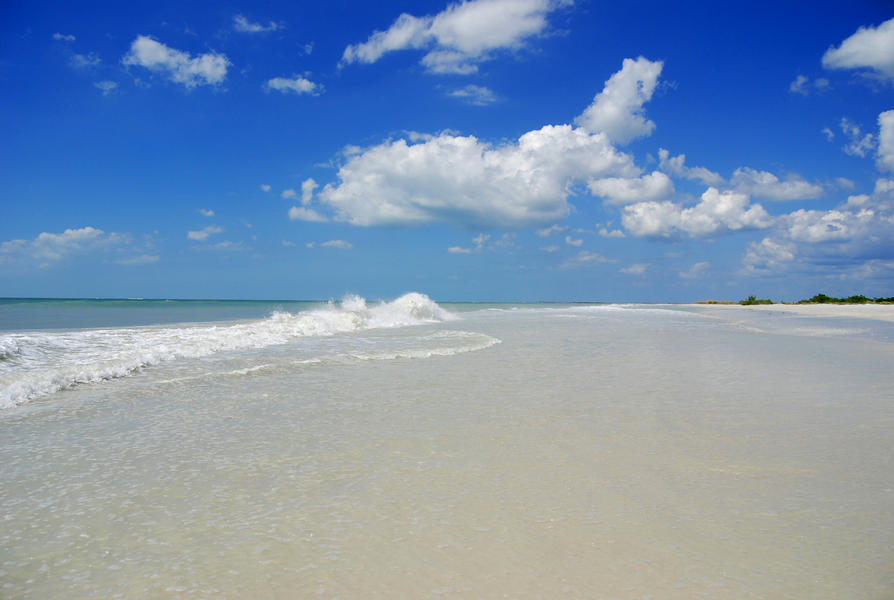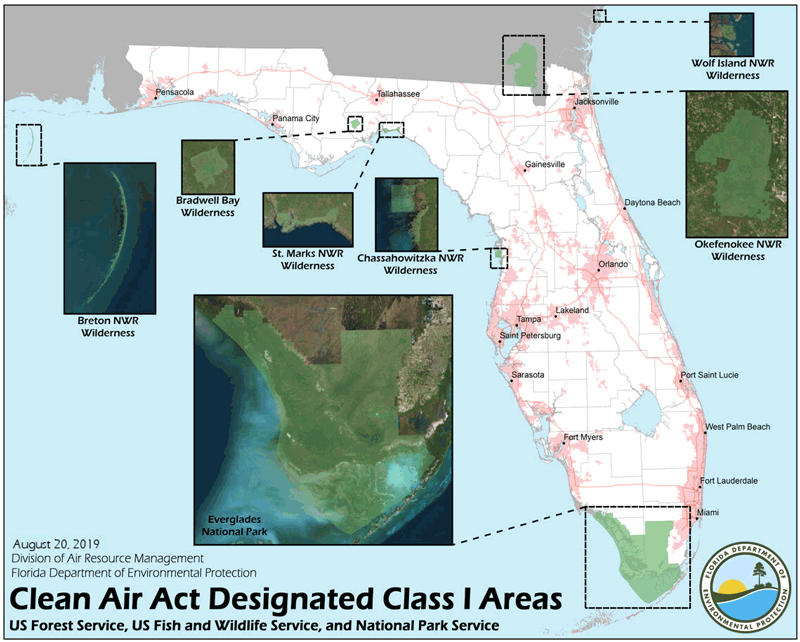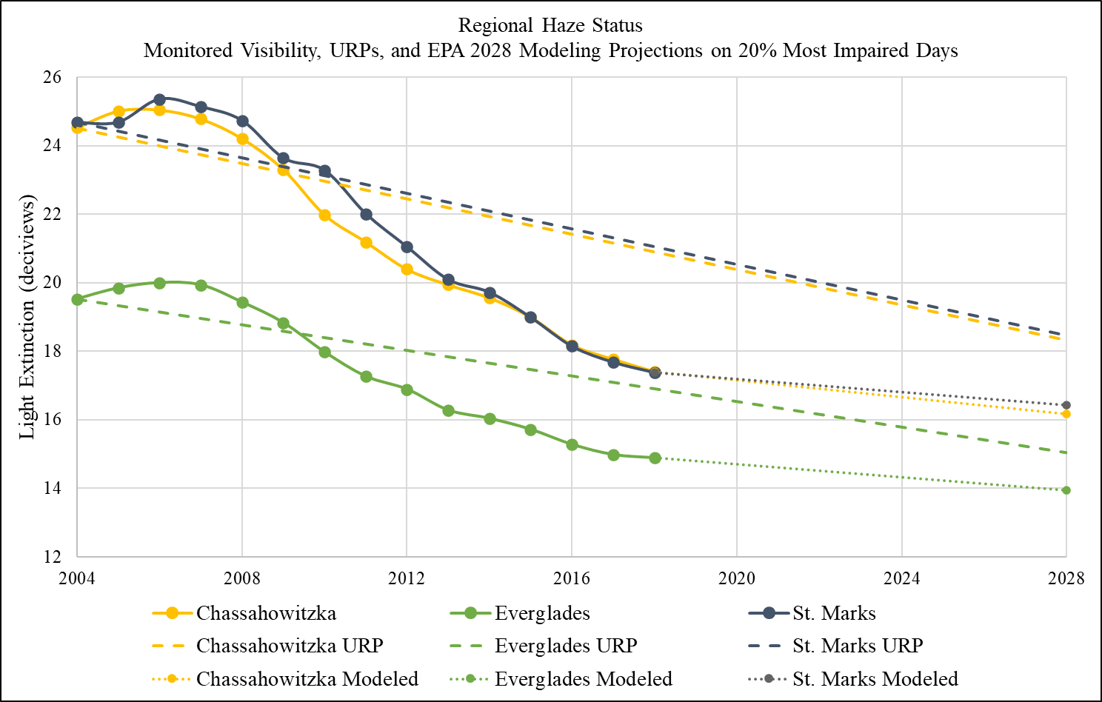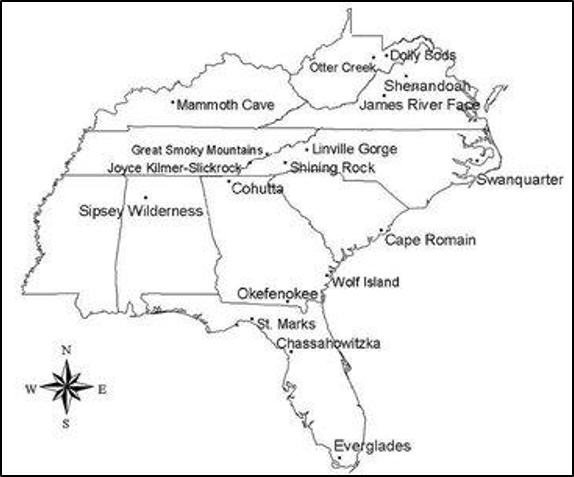

EPA’s Regional Haze Program
- Home
- Divisions
- Division of Air Resource Management
- Division of Air Resource Management (General)
- EPA’s Regional Haze Program
Air Resource Management Quick links
- NEW - Changes Without Permit Revisions
- Clean Air FL
- Guidance Memos
- 2024 Hillsborough-Polk Verification of Continued Attainment Annual Report
- 2024 Florida Ongoing Data Requirements Annual Report
- Ambient Air Monitoring Network Plan
- PSD Air Quality Modeling Best Practices
- EPA’s Regional Haze Program
- Volkswagen Settlement and Diesel Emissions Reduction Act (DERA)
- Portable Air Pollution Sensors
- Air Quality 101
- Wildfire Smoke and Air Quality
- Florida's Air Quality System
- Compliance
- Permitting
- Air Permit Documents Search
- Permit Application Subscription Service
- Electronic Permit Submittal and Processing System
- General Permits
- Contacts by Key Industry and Key Program
- Division Forms (Application, Report, Notification)
- How to Find Air Documents Online
- Interactive Maps
- Regulatory Projects
- User Account Registration (EAOR, EPSAP)
- All Air Resource Management content
In 1999, the U.S. Environmental Protection Agency (EPA) announced a major effort to improve air quality in national parks and wilderness areas. The Regional Haze Rule calls for state and federal agencies to work together to improve visibility in 156 national parks and wilderness areas such as Everglades, Grand Canyon, Yosemite, the Great Smoky Mountains and Shenandoah.
See below to learn about the work DEP is doing for the current implementation period and other background information.
Current Implementation Period (2019 – 2028)
On Jan. 10, 2017, EPA published in the Federal Register a final rule revising the Regional Haze Rule. The revised Regional Haze Rule addresses the requirements for the second implementation period (2019 – 2028). EPA has distributed final guidance on the second implementation period that DEP is following throughout the SIP development process.
The department's proposed regional haze SIP revision represents commitments and enforceable actions taken by the department to address the requirements of the Regional Haze Rule during the second implementation period from 2019 to 2028, toward the goal of attaining natural visibility conditions in Florida’s designated federal Class I areas and those federal Class I areas in other states that may be affected by emissions from Florida. Pursuant to 40 CFR 51.308(f), Florida’s regional haze plan includes the following elements:
- Calculations of baseline, current and natural visibility conditions; progress to date; and the uniform rate of progress for each Class I area.
- Documentation of the technical analysis on which Florida is relying to determine reasonable progress, including modeling, emissions and data analysis.
- Source-specific reasonable progress four-factor analyses and documentation of the source selection process.
- Long-term strategy for regional haze resulting from the reasonable progress analyses.
- Reasonable progress goals.
- A progress report addressing the requirements of 40 CFR 51.308(g)(1) through (5).
- Monitoring strategy and other implementation plan requirements.
- Documentation of consultation with other states, EPA and federal land managers (FLMs).
Below are links to Florida’s Final Regional Haze Pre-Hearing SIP for the second implementation period. The “2021-01 - Regional Haze SIP” contains administrative items related to the SIP development process. The “Florida Regional Haze Plan for the Second Implementation Period” is the main narrative portion of Florida’s regional haze plan.
- Appendices A through E include technical support materials and documentation used in developing the regional haze plan.
- Appendix F includes the documentation of the interagency consultation process. Appendix G includes documentation of the source-specific reasonable progress analyses conducted.
- Appendix H includes comments from FLMs received during the 60-day FLM consultation period.
- Appendix I includes public comments received during the 30-day public comment period, a summary of the public hearing held on July 15, 2021, and the department’s response to public comments.
A full table of appendices is available in the “Final Florida Regional Haze Plan for the Second Implementation Period” document.
- Submittal Cover Letter, dated Oct. 8, 2021.
- Final 2021-01 - Regional Haze Plan SIP, submitted to the EPA on Oct. 8, 2021.
- Final Florida Regional Haze Plan for the Second Implementation Period, submitted to the EPA on Oct. 8, 2021.
- Appendices A through E*
- Appendix F:
- Appendix F-1, Florida State-to-State Consultation.
- Appendix F-2, VISTAS Letters to non-VISTAS States.*
- Appendix F-3, EPA_FLM_Stakeholder Outreach and Presentation.*
- Appendix F-4, MANE-VU Consultation.
- Appendix G:
- Appendix G-1, Reasonable Progress Analysis Requests to Facilities.
- Appendix G-2, Reasonable Progress Analysis Facilities Response Letters.
- Appendix G-3, Facility Permits and Documentation.
- Appendix G-4, State of Florida Certified Smoke Management Plan.
- Appendix G-5, Documentation of Permanent Shutdown of BART and Reasonable Progress Units from the First Implementation Period.
- Appendix H, Federal Land Manager Consultation Documentation.
- Appendix I:
- Appendix I-1, Florida Clinicians for Climate Action Comments.
- Appendix I-2, National Parks Conservation Association, Coalition to Protect America’s National Parks and Sierra Club Public Comments.
- Appendix I-3, Public Comment via Email Campaign.
- Appendix I-4, Public Hearing Summary.
- Appendix I-5, Response to Public Comments.
*These VISTAS-wide appendices are available on the department’s FTP site, which can be accessed using Windows File Explorer. Please contact Preston McLane if there are any issues accessing the appendices.
A link to the "Florida Regional Haze SIP Submittal for the Second Implementation Period (2019 - 2028)" is also included on the Air Regulatory Projects page.
First Implementation Period (2008 – 2018)
The first regional haze SIP was due in 2007. The first implementation period required analysis of both Best Available Retrofit Technology (BART) sources and Reasonable Progress sources. BART determinations were only required for the first implementation period.
BART determinations evaluated SO2, NOX and PM10, and considered five factors:
- Costs of compliance.
- Energy and non-air quality environmental impacts of compliance.
- Any existing pollution control technology in use at the source.
- Remaining useful life of the source.
- Degree of improvement in visibility which may reasonably be anticipated to result from the use of such technology.
There were 46 BART-eligible sources in Florida.
Reasonable progress determinations evaluated only SO2 and were required to consider the four statutory factors in CAA section 169(A)(g)(1):
- Costs of compliance.
- Time necessary for compliance.
- Energy and non-air quality environmental impacts of compliance.
- Remaining useful life of any potentially affected sources.
Reasonable progress units in Florida were those with a Q/d metric greater than or equal to 50, where Q is the 2002 SO2 emissions of the unit and d is the distance from the unit to the nearest Class I area. There were 32 reasonable progress units at 15 facilities.
On Jan. 31, 2007, Florida adopted Rule 62-296.340, F.A.C., to address BART analyses and on Feb. 7, 2008, Florida adopted Rule 62-296.341, F.A.C., to address reasonable progress four-factor analyses.
On March 19, 2010, Florida submitted the initial regional haze SIP that relied on these rules to represent commitment to achieve any required reductions by 2018, the end of the first implementation period.
On Aug. 31, 2010, Florida amended the regional haze SIP to remove Rule 62-296.341, F.A.C., and propose to rely on EPA’s CAIR and Boiler MACT to satisfy reasonable progress. This SIP amendment also included case-by-case BART determinations for five facilities.
Due to the remand of CAIR, Florida amended the SIP again on Sept. 17, 2012, to replace reliance on CAIR and Boiler MACT with case-by-case BART and reasonable progress determinations for all affected sources. Florida amended the SIP one last time on March 10, 2015, to include an additional BART limit for one source. The BART and reasonable progress determinations in the final regional haze SIP are summarized below.
Of the 46 BART-eligible sources:
- Twenty-five were exempt due to meeting modeling exemption criteria, with eight receiving permits to meet the criteria.
- Nine were exempt due to shutting down.
- Two demonstrated top-level controls.
- Ten completed a full BART analysis, with eight facilities receiving permits to install new controls, upgrade existing controls or set limits.
Of the 32 reasonable progress units:
- Eight units at five facilities required a full four-factor analysis with two facilities receiving permits.
- Three units at three facilities took permit limits to reduce their Q/d to less than 50 and did not require four-factor analysis.
- Eleven units at three facilities were permitted to permanently shut down and did not require four-factor analysis.
- The remaining 10 units were located at six BART sources that completed BART determinations in lieu of four-factor analysis.
On Aug. 29, 2013, EPA gave full approval of Florida’s regional haze SIP which was submitted on March 13, 2010, as amended on Aug. 31, 2010, and Sept. 17, 2012.
On Oct. 23, 2015, EPA approved Florida’s March 10, 2015, revision to the regional haze SIP which included the additional BART limit for one source.
On March 10, 2015, Florida submitted a regional haze progress report SIP revision to EPA addressing the requirement that states submit periodic reports describing progress to date on the regional haze plan and a determination of the adequacy of a state’s existing regional haze plan. This progress report SIP demonstrated that Florida was on track to meet the visibility improvement goals set in the regional haze SIP. EPA approved Florida’s regional haze progress report SIP on Aug. 2, 2016.
Background
EPA’s regional haze program addresses requirements under the Clean Air Act (CAA) for the protection of visibility in national parks and wilderness areas designated as mandatory Class I federal areas.
The following Class I areas in or near Florida are subject to the Regional Haze Rule:
- Chassahowitzka National Wildlife Refuge.
- Everglades National Park.
- St. Marks National Wildlife Refuge.
- Okefenokee National Wildlife Refuge (Georgia).
- Wolf Island National Wildlife Refuge (Georgia).

Visibility in Class I areas can be affected by regional haze caused by the cumulative effects of numerous sources located over a wide geographic area.
The regional haze program aims to improve visibility on the 20% most impaired days (previously the 20% haziest days) and ensure visibility does not degrade on the 20% best days in Class I areas. Progress in visibility improvement is compared to each Class I area’s uniform rate of progress (URP), which extends from visibility conditions in the baseline period of 2000-2004 to natural visibility conditions in 2064.
The figure below shows the current monitored visibility in each Florida Class I area and the projected visibility in 2028 from EPA’s Regional Haze Modeling. Visibility conditions are currently well below the URP and are projected to remain below the URP with on-the-books controls.

EPA’s Regional Haze Rule initially promulgated July 1, 1999, requires states to submit a series of SIPs to ensure reasonable progress toward natural visibility conditions in Class I areas. As part of the SIP development process, states must evaluate and determine whether any cost-effective emission reduction measures and strategies are available to ensure reasonable progress in the current implementation period.
SESARM (Southeastern States Air Resource Managers Inc.) coordinates regional haze planning for ten Southeastern states, including Florida, through the regional planning organization VISTAS (Visibility Improvement State and Tribal Association of the Southeast). VISTAS is responsible for convening state, local and tribal air pollution control agencies in the Southeast and collaborating on regional air quality analysis work necessary to support development of regional haze SIPs.

Interested in subscribing to DEP newsletters or receiving DEP updates through email?
Sign UpAbout DEP
The Florida Department of Environmental Protection is the state’s lead agency for environmental management and stewardship – protecting our air, water and land. The vision of the Florida Department of Environmental Protection is to create strong community partnerships, safeguard Florida’s natural resources and enhance its ecosystems.
Learn MoreContact
3900 Commonwealth BoulevardTallahassee, Florida 32399-3000 Public.Services@FloridaDEP.gov 850-245-2118
